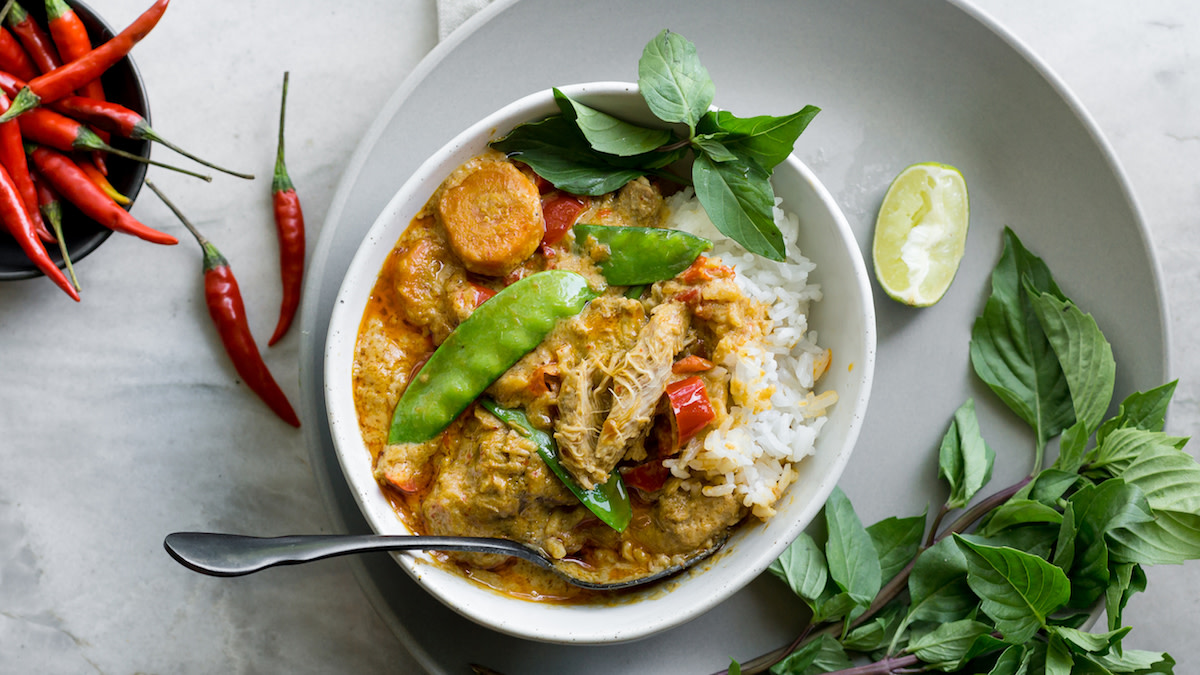
Course
Main
Duration
2-3 hours
Serves
4
Panang curry is a rich, coconut-based dish that’s popular in Thai cuisine. Traditionally this curry is made using beef and very few vegetables. But, authenticity be damned, I often use wild game, snow peas, and carrots. I find that the sauce benefits from a long simmer, which I like to use as an opportunity to slow cook tough cuts of meat.
A good Thai curry is well rounded and full of flavor. Each brand of curry paste will be different, so I suggest you taste the sauce towards the end of cooking and add ingredients to adjust to your taste. The measurements below work well for me, but I usually still end up giving an extra squeeze of lime or pinch of sugar to get it just right.
Some ingredients in an authentic Thai curry can be difficult to find. For that reason, you’ll notice I exchanged lime juice for kaffir lime leaves and brown sugar for palm sugar. The only ingredient that I wouldn’t substitute, and I strongly suggest finding, is the fish sauce. It’s a make-or-break flavor that is necessary in Thai cuisine.
Ingredients
- 1 1/2 lb. pheasant thighs
- 1 shallot, thinly sliced
- 1 tbsp. minced ginger
- Thai chilis (1 for mild, 2 for medium, 3+ spicy)
- 1/4 cup Panang curry paste
- 1 can of coconut milk (14 oz.)
- 1 can of coconut cream (14 oz.)
- 1 tbsp. fish sauce
- 1 lime, juiced (or 4 kaffir lime leaves, shredded)
- 2 tbsp. peanut butter
- 2 tbsp. brown sugar (or palm sugar)
- 1 red bell pepper, sliced
- 2 carrots, cut into 1/2” rounds
- 1 handful of snow peas (optional)
- Coconut oil for cooking
- Jasmine rice and Thai basil for serving
Also works with
Special equipment
Preparation
- Prep the meat by de-boning the legs and cutting into small chunks. If using venison or boar roasts, you will need to cut the meat into thin slices for quicker cooking.
- Set a large pot or wok over high heat. Add a teaspoon of coconut oil and brown both sides of the meat until golden. Work in batches and add more oil if needed. Remove the meat and set aside.
- Add another teaspoon of coconut oil and sauté the shallot, ginger, and Thai chilis until soft. Create a well in the middle of the aromatics and add a tablespoon of coconut oil. Once oil is hot, add the curry paste and fry it in the oil. This brings out the aroma and flavors of the paste. Continue stir-frying the paste and mixing with the other ingredients.
- Pour the coconut cream, coconut milk, fish sauce, lime juice, peanut butter, and sugar into the wok. Stir until well combined. Add the bell peppers, carrots, and return the meat.
- Reduce heat to the lowest setting, place a lid on top, and allow the curry to gently simmer until the meat is fork tender. Depending on how big your chunks are, this could take up to a couple hours. Near the end of cooking, add in the handful of snow peas. They should cook until tender, but still be bright green with a little crunch.
- Taste the curry sauce and make adjustments. The curry should be intensely flavorful, yet balanced. Add extra sugar if it is too acidic, lime juice if it is too rich, or fish sauce if you desire more salt.
- Serve the curry over jasmine rice with plenty of Thai basil.
Sign In or Create a Free Account
Reviews
Panang curry is a rich, coconut-based dish that’s popular in Thai cuisine. Traditionally this curry is made using beef and very few vegetables. But, authenticity be damned, I often use wild game, snow peas, and carrots. I find that the sauce benefits from a long simmer, which I like to use as an opportunity to slow cook tough cuts of meat.
A good Thai curry is well rounded and full of flavor. Each brand of curry paste will be different, so I suggest you taste the sauce towards the end of cooking and add ingredients to adjust to your taste. The measurements below work well for me, but I usually still end up giving an extra squeeze of lime or pinch of sugar to get it just right.
Some ingredients in an authentic Thai curry can be difficult to find. For that reason, you’ll notice I exchanged lime juice for kaffir lime leaves and brown sugar for palm sugar. The only ingredient that I wouldn’t substitute, and I strongly suggest finding, is the fish sauce. It’s a make-or-break flavor that is necessary in Thai cuisine.
Ingredients
- 1 1/2 lb. pheasant thighs
- 1 shallot, thinly sliced
- 1 tbsp. minced ginger
- Thai chilis (1 for mild, 2 for medium, 3+ spicy)
- 1/4 cup Panang curry paste
- 1 can of coconut milk (14 oz.)
- 1 can of coconut cream (14 oz.)
- 1 tbsp. fish sauce
- 1 lime, juiced (or 4 kaffir lime leaves, shredded)
- 2 tbsp. peanut butter
- 2 tbsp. brown sugar (or palm sugar)
- 1 red bell pepper, sliced
- 2 carrots, cut into 1/2” rounds
- 1 handful of snow peas (optional)
- Coconut oil for cooking
- Jasmine rice and Thai basil for serving
Also works with
Special equipment
Preparation
- Prep the meat by de-boning the legs and cutting into small chunks. If using venison or boar roasts, you will need to cut the meat into thin slices for quicker cooking.
- Set a large pot or wok over high heat. Add a teaspoon of coconut oil and brown both sides of the meat until golden. Work in batches and add more oil if needed. Remove the meat and set aside.
- Add another teaspoon of coconut oil and sauté the shallot, ginger, and Thai chilis until soft. Create a well in the middle of the aromatics and add a tablespoon of coconut oil. Once oil is hot, add the curry paste and fry it in the oil. This brings out the aroma and flavors of the paste. Continue stir-frying the paste and mixing with the other ingredients.
- Pour the coconut cream, coconut milk, fish sauce, lime juice, peanut butter, and sugar into the wok. Stir until well combined. Add the bell peppers, carrots, and return the meat.
- Reduce heat to the lowest setting, place a lid on top, and allow the curry to gently simmer until the meat is fork tender. Depending on how big your chunks are, this could take up to a couple hours. Near the end of cooking, add in the handful of snow peas. They should cook until tender, but still be bright green with a little crunch.
- Taste the curry sauce and make adjustments. The curry should be intensely flavorful, yet balanced. Add extra sugar if it is too acidic, lime juice if it is too rich, or fish sauce if you desire more salt.
- Serve the curry over jasmine rice with plenty of Thai basil.






